Virtual and Augmented Reality Market: Prospects for Startups from an Investor's Point of View
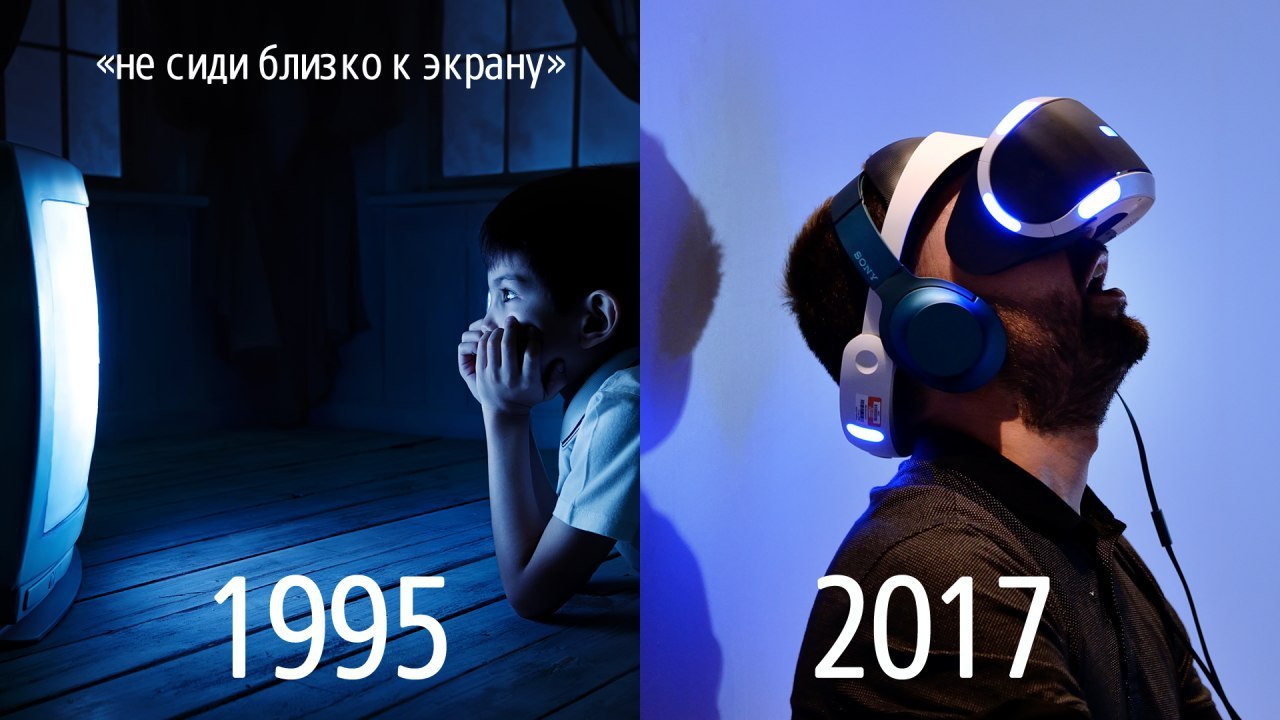
At the autumn Spb Startup Day, the investment manager of IIDF Ilya Korolev spoke about the VR / AR-solutions market and shared his opinion on which startups from this sphere are more interesting to invest in and why, as well as figures on the market size and investments in virtual and augmented reality. We publish material on the results of performance with a few additions.

On behalf of IIDF, I invest in IT companies in the seed and round A stages, which showed good growth and potential at the end of the Accelerator. Or it could be companies that have not passed Accelerator, earn from 30-40 million rubles a year and are looking for money to scale in Russia or abroad.
')
The direction of VR / AR, I began to actively explore almost two years ago. The market is at a very early stage of development, but at the same time it is extremely attractive for investors, as it can potentially become very large and even surpass the market of mobile devices. Over the past year, more than $ 2 billion has been invested in the industry. Russia and its engineers have a great potential to become one of the key suppliers of technological and product solutions for this market.
The history of the emergence of terms and the spectrum of realities
Let's start from afar. The spectrum of realities that Paul Milgram formulated in 1994: from the physical environment (all objects are real, they can be felt) to completely virtual (all objects and the environment are computer-generated). Denote the differences between the main types of realities.
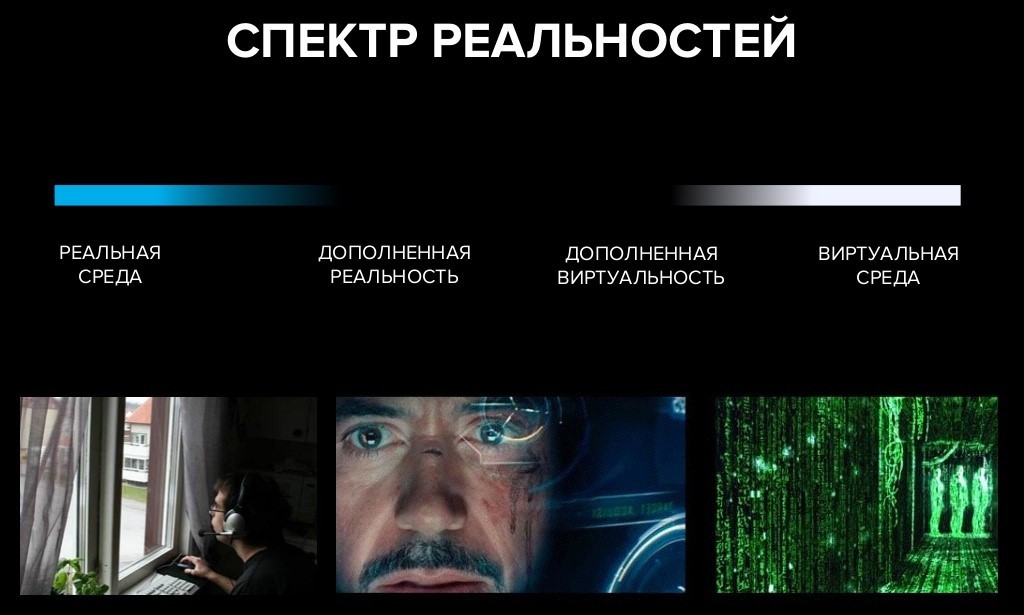
Milgram's Reality-Virtuality Spectrum (1994)
Virtual reality (VR) - a closed computer simulation of a certain environment around a user who is fully immersed in the virtual world. The task of virtual reality is to use the various human receptors (sight, hearing, smell, tactile sensations) to immerse the user as much as possible into virtual reality. A person begins to feel himself inside a virtual simulation environment, and in the presence of a system with the possibility of feedback, an imitation of physical sensations arises.
The term artificial (virtual) reality was first formulated by American computer artist Myron Kruger in the late 60s - the first attempts to create tools that allow you to immerse yourself in virtual reality began to appear during this period.
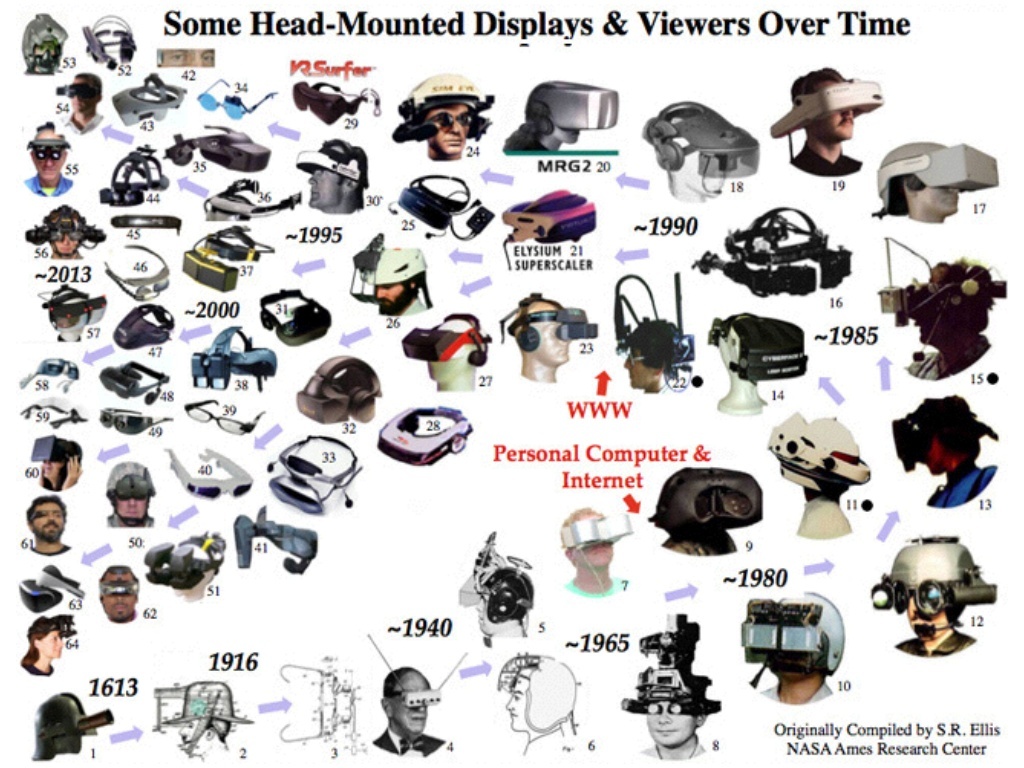
The evolution of virtual and augmented reality glasses
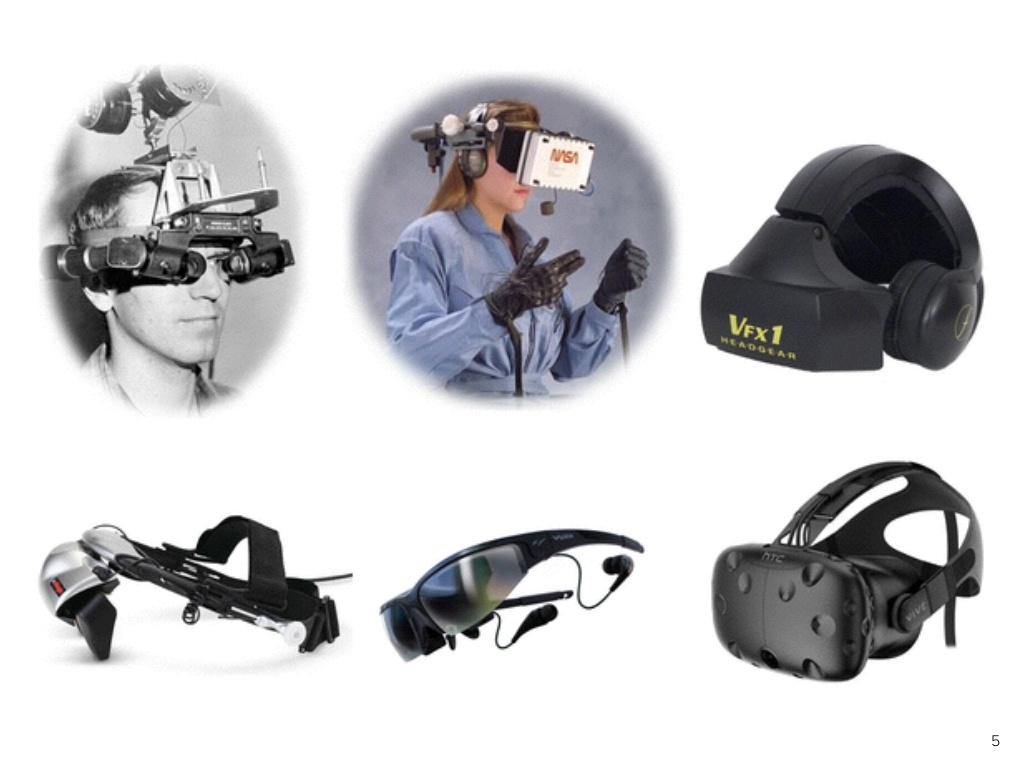
Augmented reality (augmented reality, AR) - the imposition of layers, computer-generated, on the existing reality, as a result of which the existing reality is improved. The first points of augmented reality were attempted to be made back in 1613 in the form of a helmet, which allows you to additionally see some objects (there is in the picture above). One of the examples of augmented reality is information for the pilot projected on the windshield of the cockpit in an airplane (speed, weather changes and other indicators).
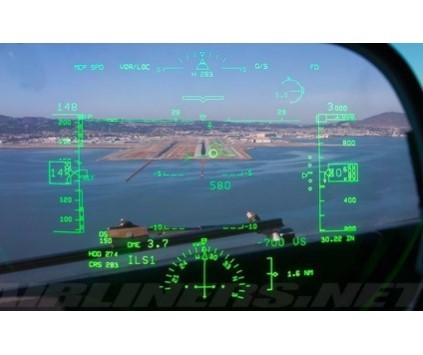
Another example is when you point a smartphone at a building, and the screen displays information that there is a coffee shop or spa in this building.
Tools of augmented reality tried to create in the 15th century architect Filippo Brunelleschi. He drew an object that complemented another existing in the real world - and offered to look at it through a mirror with a hole.
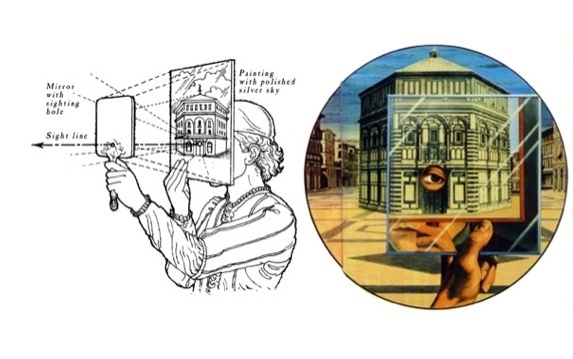
But the term "augmented reality" was proposed by a 1990 researcher of Boeing Corporation Tom Kodel. The spectrum of this type is closer to the real environment.
The market of virtual and augmented reality is gaining momentum, and every year more and more technologies appear in this area. Let us see where they can be applied.
Applications of VR / AR solutions
Entertainment Anyone who starts to engage in virtual and augmented reality, first of all go into entertainment, games, video, 360 degrees. But in my opinion, it is more interesting to look at other possibilities of applying these technologies.
Design . Designers and designers with the help of augmented and / or virtual reality helmets increase the efficiency of their work. There are solutions that allow designers from different countries to simultaneously work with one object in real time, which increases the efficiency of the production process or model and solves problems with communication. VR technologies can be used in prototyping and modeling, in production during assembly of products.
Sport An interesting case of using virtual reality was in sports in the United States: when an American football player was preparing for a match, he put on a virtual reality helmet and simulated the start of the game and its position on the field. So he was working out experience and working with a trainer on one or another strategy.
MIC . One of the pioneers of using virtual and augmented reality is the military. In the virtual world or with the help of augmented reality, they simulate fighting, demining or other operations to reduce the likelihood of error in a real environment.
Medicine In this area, VR technologies are also beginning to be used more and more often - starting from conducting virtual training of doctors on how to operate correctly, to using virtual reality for the rehabilitation of patients and the treatment of phobias (fear of heights, spiders and others). Immersion in virtual reality creates an effect of presence, which increases the effectiveness of rehabilitation / treatment. For example, the Russian company Intellect and Innovations creates a rehabilitation complex consisting of virtual reality display devices for partial and complete immersion, a motion capture system and feedback mechanisms. The complex is used for the rehabilitation of stroke patients who need to restore motor skills.
There are actually many more spheres, their analysis deserves a separate material, but we will focus on market volumes and technology investment amounts.
Trend of virtual and augmented reality: technology maturity cycle
Virtual reality experienced several rounds of development. We are now seeing a new round in which for the first time virtual reality has a massive effect.
The revolution that we are now witnessing is a consequence of the emergence of the so-called “fourth platform”.
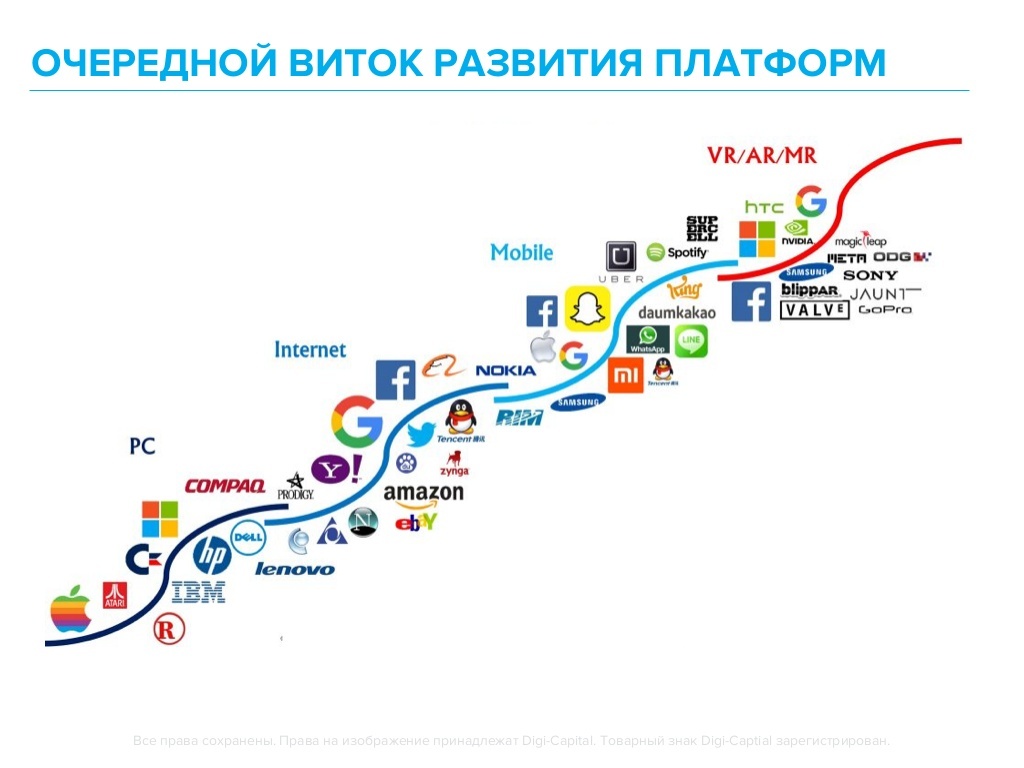
The first platform - personal computers, which appeared in the late 80s - early 90s, then the Internet came, the next stage was mobile technology. Now mobile consumption is already more than on personal computers. Virtual and Augmented Reality is the next platform for which new markets, offers and business will be created. Now is the very moment when you need to invest in VR / AR and develop technologies in this area.
There is a hype cycle - a cycle or technology maturity curve, which was proposed in 1995 by research company Gartner. Each technology on the market passes a certain stage of this cycle. Version 2016 looks like this:
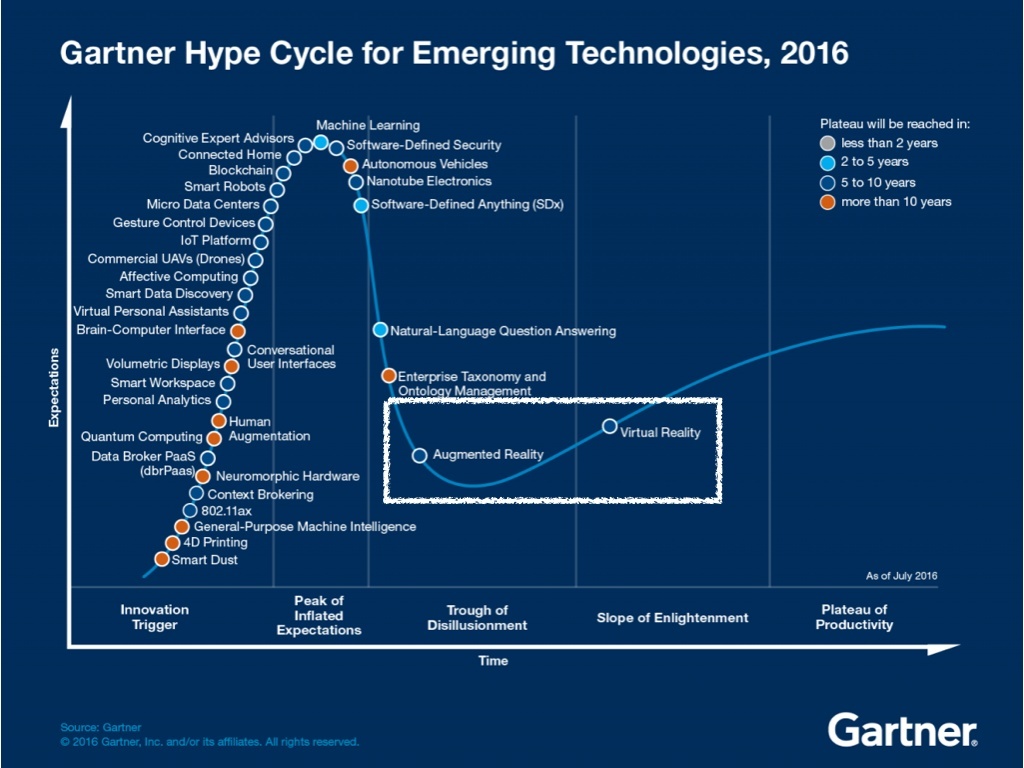
The first stage is a “trigger”, when nobody knows about technology at the beginning of the journey, only scientists and enthusiasts are involved in it, no one invests in it.
The second stage is “the peak of excessive expectations.” More and more people are learning about technology, the collective expectation of a boom, a surge of interest in it is growing. During this period, in the mid-90s, Nintendo released virtual reality gadgets, but only 700 of them were sold. The quality of the content and the resolution of the existing screens was not enough to create a massive effect.
Therefore, in the hype, which was in virtual reality in the early to mid-90s, they became disillusioned and waited for what would happen next. “Disappointment” is the third stage in the technology maturity cycle. Now it contains augmented reality.
The starting point of the last round of VR development I would call the success of the Oculus virtual reality helmet and its crowdfunding campaign on Kickstarter.
Now, the virtual reality of the technology maturity cycle is at the fourth stage - “enlightenment”: solutions to the main problems of the technology have already been found, there is a lot of high-quality content and an audience. At the same time, VR is approaching the fifth stage - the “plateau of productivity”, when the technology becomes ordinary, its use turns into a routine. An increasing number of people will use virtual reality in everyday life. One of the drivers for the development of the VR market, so that it will become truly massive will be mobile VR. Samsung and Google put high hopes on it.
Market volume - forecasts
According to analysts, now the market volume of virtual and augmented reality in the proceeds from sales of content and devices is several billion dollars, but by 2020 it will be more than $ 150 billion (see figure).

This is a great opportunity for startups and investors. Now the main revenue is generated by virtual reality helmets and the content that is created for them. But the picture will change - a big bet will be made on augmented reality. This can be seen from the diagram above.
Blue graph - revenue from services, content and points that create augmented reality. We see that the share of virtual reality in revenue is much smaller, although so far it is she who creates the main HYIP.
The projected gigantic size of the market gives rise to enormous opportunities to create your own business. Recall Apple and their mobile apps: the iPhone revolutionized the smartphone market. Who earned the most? Developers who began to make applications for smartphones. Since the application market was very small, the demand for them was large due to the distribution of these devices. Almost everything that came to hand was bought and downloaded - they could shoot games that previously seemed impossible at all. Due to the high demand and small supply on the market, asymmetry was created, on which smart people earned money.
Investments in virtual and augmented reality
Investments in the industry are growing, and several peaks can be observed.

The first small peak: Facebook buys Oculus in the first quarter of 2014. The next jump occurs in the first quarter of 2016 - the peaks are largely due to investments in Magic Leap (more than $ 1.5 billion invested by Andreessen Horowitz, Kleiner Perkins, Google, JPMorgan, Fidelity, Alibab). All major players have moved into this area: Google, Apple, Samsung. Not just HYIP is happening now, - market players and analysts have confidence that this technology will fire. The only question is who will collect the cream.
The projected level of revenue from sales of content and products in virtual reality is $ 30 billion by 2020, in augmented reality, $ 120 billion, the breakdown by spheres is shown below.
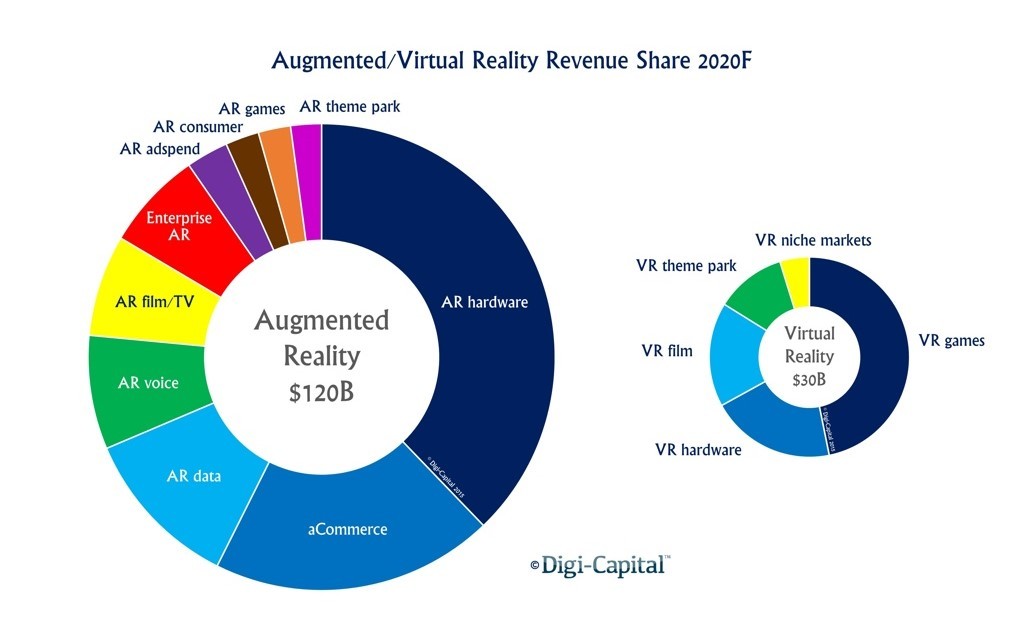
There are already exits from startups in this area - due to the purchase of shares in companies by other players. Below are examples of large exits.
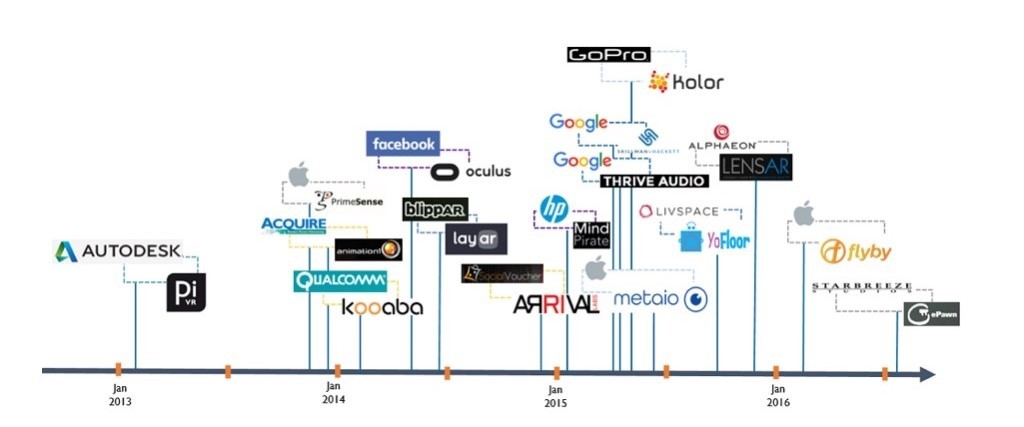
Where is the money in virtual and augmented reality
On markets that are interesting for investing - at the beginning of the text: these are medicine, design, military-industrial complexes, as well as training and education. Conceptually, the money in VR / AR, in my opinion, is “buried” at the interface of expertise in the technology itself and industry expertise.

As it was clear from the revenue forecasts in the industry, a significant proportion of the expected revenue falls on hardware and content. VR / AR startups are mainly divided into these two areas. The main advantages and pitfalls of each of the spheres:
Content:
- Low entry threshold, but highly dependent on niche.
- Entertainment content is an area in which beginners in the industry mostly try themselves. But the main difficulty in the development of games is difficult to predict success, in fact, this is roulette.
- Cognitive content - the business model in this area is complicated by the fact that it is difficult to scale.
- Educational content that really brings effect is really interesting for the investor. Especially in b2b, if the result of the implementation for business is easy to calculate.
"Iron":
- High capital intensity of R & D and entry to the market (just a story about Magic Leap with billions of investments in the absence of a product).
- The success of a product on crowdfunding platforms like Kickstarter and IndieGogo does not always anticipate the great demand in b2c: you can get into geeks and innovators, as happened with Ouya. The company collected about $ 10 million at Kickstarter, but it ended up failing, including due to the lack of mass of the target audience.
“With all this, the projected income from hardware is quite high.
Startups in the realms of virtual and augmented reality are interesting for IIDF as potential investments. You can submit an application to the 12th Accelerator before March 6, startups come to us with a ready-made IT product at the stage from first sales or users to a turnover of 5 million rubles. Potentially achievable market volume should be 300 million rubles per year in 3-5 years. Teams that have passed the selection will receive a pre-seed investment from the IIDF 2.1 million rubles. and the chance to attract the next rounds - including from other investors.
Source: https://habr.com/ru/post/322230/
All Articles